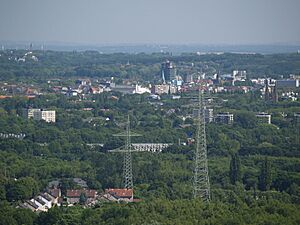Herne, North Rhine-Westphalia facts for kids
Quick facts for kids
Herne
|
|||
|---|---|---|---|

View towards the center of Herne
|
|||
|
|||
| Country | Germany | ||
| State | North Rhine-Westphalia | ||
| Admin. region | Arnsberg | ||
| District | Urban district | ||
| Elevation | 65 m (213 ft) | ||
| Population
(2022-12-31)
|
|||
| • Total | 157,368 | ||
| Time zone | CET/CEST (UTC+1/+2) | ||
| Postal codes |
44601-44653
|
||
| Dialling codes | 02323, 02325 | ||
| Vehicle registration | HER, WAN | ||
| Website | herne.de | ||
Herne (German pronunciation: [ˈhɛʁnə]) is a city in North Rhine-Westphalia, Germany. It is located in the Ruhr area directly between the cities of Bochum, and Gelsenkirchen.
Contents
History
Herne (ancient Haranni) was a tiny village until the 19th century. When the mining of coal (and possibly ore) and the production of coke (the fuel processed from the harvested coal) and steel began, the villages of the Ruhr area had an influx of people, mostly from the east of Germany.
Herne is located on the direct axis between Bochum to the south and Recklinghausen to the north, with Münster in the north, Gelsenkirchen to the west, and Castrop-Rauxel and Dortmund to the east. The physical border between Herne and Recklinghausen is the bridge at the Bochumer Strasse across the Rhine–Herne Canal. A little further north of the canal flows the Emscher river, with the former abundance of wild horses that were caught in the Emscher Valley (Emschertal), then sold and/or traded at the yearly horse market at Crange, which later developed into the "Cranger Kirmes". After World War II, Herne was known as "Die Goldene Stadt" ("The Golden City") because of the comparatively limited damage suffered during World War II.
Present-day Herne includes the former settlements of Haranni, originating at the south end of the Bahnhofstrasse and just across the Evangelische Hauptkirche Herne (main Lutheran Church—seems to be called "Kreuzkirche" now) and the crossing of Sodingerstrasse, running to the east at that point, then turning into Wiescherstrasse; formerly independent settlements or villages like Baukau, Börnig, Crange, Horsthausen, Pöppinghausen, Sodingen, and others became the present Herne. These farms bearing these names were probably or possibly found in the 11th and 12th centuries. In 1860, the first of a number of coal mines started operating. In the following thirty years, the population increased twenty-fold. In 1975, Wanne-Eickel, by then a city with over 70,000 inhabitants, was incorporated into Herne, which had a population larger than "Wanne-Eickel" at that point in time.
World War II
Herne was targeted by the Royal Air Force on 4 June 1940, early in World War II, and air raids became daily and nightly occurrences. On one occasion, three high-explosive torpedo-bombs were dropped, severely damaging a number of houses in the Vincke-Strasse (only some of the outer shell had remained) and resulting in the deaths of all the inhabitants. Phosphorus bombs were dropped in several locations and caused fires that lasted for days. The canal was the major mode of transportation for coal and coke from the many coal mines in the area to the factories for iron ore to be processed into steel (Blau-Stahl), and coal was transported along the inter-connecting waterways in all other directions to be used for industrial as well as domestic use. In particular, the bridge across Rhine–Herne Canal, closest to the easternmost double-chambered lock and the wharf on the north shore, was hit and taken out.
The Krupp Treibstoffwerke oil refinery near the local Shamrock, ¾ of the coal mine, was bombed during the oil campaign of World War II.
Gallery
The largest communities of migrants:
| 10,130 | |
| 2,139 | |
| 1,865 | |
| 1,140 | |
| 1,066 | |
| 792 |
Notable places
A fair called Cranger Kirmes is held in the city's Crange district every first week of August. This is the second largest-carnival in Germany, with an average of around 4.5 million visitors. Its origins can be traced back to the 15th century, when farmers started trading horses on Saint Lawrence's Day. The horse show and horse equipment sales were arranged at the same place where horses were traded years ago for tradition.
Notable people
Famous Hernians or Wanne-Eickelians include:
- Cigdem Akyol
- Yıldıray Baştürk
- Kurt Edelhagen
- Gudrun Heute-Bluhm
- Andrea Jürgens, Dr. Claudia Dollins (Geier)
- Jürgen von Manger, known as "Mr. Tegtmeier", Tegtmeiers Reisen
- Jürgen Marcus
- Bernd Storck
- Peavy Wagner
- Leonie Saint
- Bärbel Beuermann
- Gregor Willmes, musicologist
- Rudolf Witzig
- Jan Zweyer
Notable business
- Heitkamp BauHolding, founded 1892, specialized construction work in different construction business areas
Sports
Herne is home to several football clubs, including SC Westfalia Herne, DSC Wanne-Eickel and SV Sodingen. Herne-West is a mockery name of the football club Schalke 04, most commonly used by the fans of Borussia Dortmund.
Sister cities
Herne is twinned with:
 Hénin-Beaumont, France (1954)
Hénin-Beaumont, France (1954) Castleford, England, United Kingdom (1956)
Castleford, England, United Kingdom (1956) Altagracia, Nicaragua (1988)
Altagracia, Nicaragua (1988) Moyogalpa, Nicaragua (1988)
Moyogalpa, Nicaragua (1988) Belgorod, Russia (1990)
Belgorod, Russia (1990) Eisleben, Germany (1990)
Eisleben, Germany (1990) Konin, Poland (1991)
Konin, Poland (1991) Beşiktaş, Turkey (2016)
Beşiktaş, Turkey (2016) Luzhou, China (2018)
Luzhou, China (2018)
See also
 In Spanish: Herne para niños
In Spanish: Herne para niños






